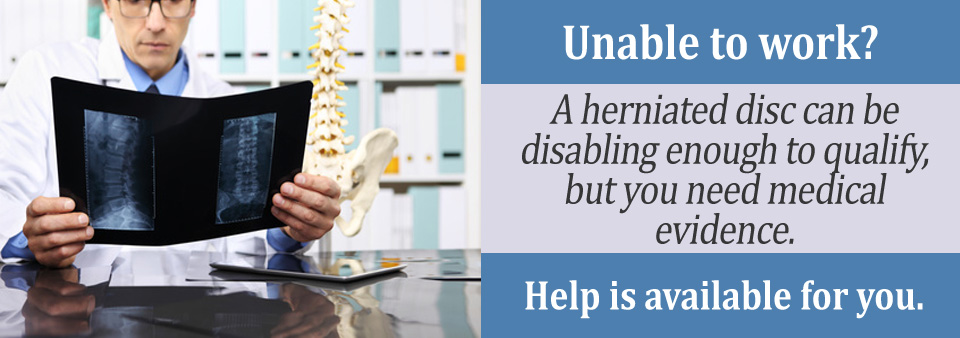If you are unable to work and earn a living because of a herniated disc, you will want to apply for disability benefits administered by the Social Security Administration (SSA). When you apply for disability benefits, you should complete the disability application in detail.
The reason most claims are denied is because they lack supporting evidence. To prove that your herniated disc medically qualifies for disability benefits, you must provide hard medical evidence that details your condition and its severity.
Medically Qualifying for Disability with a Herniated Disc
Herniated discs have a listing in the Blue Book, which is the medical guide used by the SSA to determine if an individual’s condition medically qualifies for disability benefits. To qualify for disability with a herniated disc per the listing, you will need to show that your medical condition:
Results in compromise of a nerve root or the spinal cord, and does so by such as:
- Causing distributed pain, limited spinal motion, and/or causes motor loss because of the atrophying of unused muscles
- Causes sensory or reflex loss AND
- If the involvement is the lower back, limits motion in the legs measured with a positive straight-leg raising test (SLR test)
Your medical records must provide the details and evidence to support these claims. That includes detailed physician notes, a confirmed diagnosis by imaging, imaging reports – such as CT scans, x-rays, and MRIs, SLR test results, and the results and reports from any other medical tests associated with your back.

Qualifying with a Medical Vocational Allowance
If you cannot qualify for disability through the listing, you may still qualify using a medical vocational allowance. This approach takes your age, work history, transferrable skills, and educational background into consideration along with your medical conditions, treatment, symptoms, and side effects. One important document provided when using the medical vocational allowance is the residual functional capacity (RFC) form.
The RFC is completed by your treating physician. It will detail what you can and cannot do, clearly indicating restrictions and limitations. For example, it may say you must reposition every hour, or you cannot stand more than 30 minutes. If you must take painkillers that cause drowsiness, you will not be allowed to operate heavy machinery or drive a vehicle. Your medication may cause confusion and you may have difficulty focusing. The RFC will allow the disability examiner to determine what jobs you can do if you can work at all.
Applying for Disability Benefits
If you are unable to work because of a herniated disc, you will want to get your disability claim underway. You will need to gather all your medical reports and supporting documentation before you get your claim underway, so you can make sure that your claim will be reviewed fairly and that the disability examiner has a clear picture of how you are affected by your back problems. For help with your claim, complete the Free Case Evaluation above and get connected with a lawyer that takes cases in your area.
Additional Resources
- Using An RFC When Applying For Benefits With A Herniated Disc
- What is Included in My Disability Application for a Herniated Disc?
- Can I Continue Working with a Herniated Disc?
- Is Disc Desiccation a Disability?
- Permanent Restrictions After Developing a Herniated Disc
- What Happens After You Get Your Award Letter from Social Security?